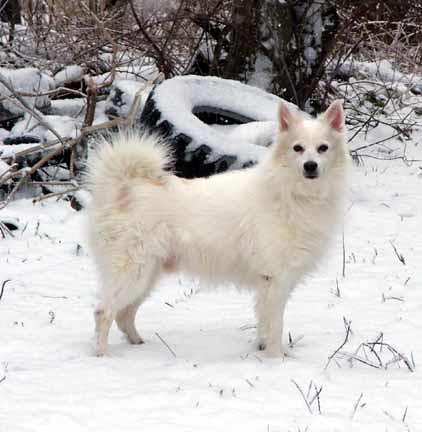American Eskimo Dog
History of the breed
The American Eskimo Dog is a breed of companion dog and semi-sled dog originating in the USA. In addition to serving as a companion, it has been used as a watchdog, sled dog, and also achieved a high degree of popularity in the 1930s and 1940s United States as a circus performer. The American Kennel Club recognized the breed in 1994 and set the current standard for the breed.
Appearance of the breed
The standard for the American Eskimo Dog calls for them to be white or white & biscuit cream, with brown eyes (blue eyes, such as those found on the Siberian Husky, are a disqualification and a sign of poor health or breeding), and a compact body. The dog's length should be only slightly greater than its height at the shoulder. The muzzle is long and lupine. The ears are held erect and alert, and the tail should be feathered and loosely curled on the dog's back. These dogs look very much like smaller versions of the Samoyed, and come in three standard sizes. The toy is from 9 to 13 inches at the withers; the miniature is from 12 to 15 inches; the standard is from 16 inches up to and including 21 inches. Eskies have erect, triangular ears ("prick ears"), a tail that flips onto the dog's back in a spiral, and two coats of fur: an undercoat that is softer and helps insulate the dog, and a harsher outer coat that acts as a weather repellent.
The Eskie, a loving companion dog and semi-working dog, presents a picture of strength and agility, alertness and beauty. It is a small to medium-size Nordic type dog, always white, or white with biscuit cream. The American Eskimo Dog is compactly built and well balanced, with good substance, and an alert, smooth gait. The face is Nordic type with erect triangular shaped ears, and distinctive black points (lips, nose, and eye rims). The white double coat consists of a short, dense undercoat, with a longer guard hair growing through it forming the outer coat, which is straight with no curl or wave. The coat is thicker and longer around the neck and chest forming a lion-like ruff, which is more noticeable on dogs than on bitches. The rump and hind legs down to the hocks are also covered with thicker, longer hair forming the characteristic breeches. The richly plumed tail is carried loosely on the back.
Temperament of the breed
American Eskimo Dogs thrive on being a part of a human family. Their history as a small general-purpose and a farm dog means that they are generally highly intelligent, trainable, and moderately independent. At home, they make excellent watchdogs, barking to announce the presence of strangers. The Eskie can be protective of its home and family, but in general they will not threaten to attack or bite a person unless provoked. As with all dogs, temperament is partially inherited and partially trained. Some dogs are prone to excessive barking and separation anxiety. It is important to research the dog's pedigree as their temperament may vary due to inheritance. This breed is not a fast-maturing one, and Eskies can behave more like puppies than like adults for up to two years, when they finally start to mature and grow their adult coats. They are also a very intelligent dog and need to be stimulated. When their intelligence is not stimulated or they are ignored, they can develop behavior issues. Owners can avoid this problem by socializing their Eskie through obedience training or participating in dog sports, such as dog agility, flyball,and dancing.
Health Concerns of the breed
The breed lives on average between 12 and 14 years, although some individuals might live as long as 20 years or longer. The Eskie is a fairly healthy breed. Health testing should be performed by all responsible breeders and anyone purchasing a puppy should be aware of the genetic problems which occur in the breed- PRA (Progressive Retinal Atrophy), luxating patella, and hip dysplasia. None of these are terribly common and the breed is generally healthy, however, ethical breeders check for these conditions.
In addition to the problems above, the breed can have a tendency towards allergies and tear-staining and the propensity towards these traits is inherited- do not purchase a puppy from parents which have extreme tearstaining or allergies and you will likely avoid them. Eskies can, like many long-coated dogs, be prone to flea allergies and the resulting skin irritation can be difficult to clear up.
Grooming the breed
Eskies have a long, dense coat and need regular grooming. This means brushing them once a week, or more often if necessary. They shed, but it can be maintained with regular brushing. They "blow" their coats twice a year, once in May or June (depending on the location in which they live) to shed their winter undercoat and once in November or December to shed their summer coat. Males may only shed once a year. Many Eskie owners use an undercoat rake, a tool available at most pet stores, for grooming. Some owners in hot climates do shave their Eskies, but if this is done, the dogs should be kept indoors as much as possible to prevent sunburn. Some people believe that once a dog is shaved, the coat will grow in with a coarser, woollier texture than it would have had it been left alone, but it varies by individual dog.
Although Eskies prefer cold weather, they can live in hotter climates as well. Eskies should not be shaved, as the long fur helps to maintain the temperature of their skin.
Eskies typically only need to be bathed only every two or three months, unless they soil their coat with large amounts of dirt or substances with strong odors. Regular brushing maintains a clean coat in most cases. Eskies are a very clean breed and constantly groom themselves.








